| Back to Back Issues Page |
 |
|
Feb. 2021 Trail Bytes: Are You Using Oxygen Absorbers? February 26, 2021 |
| Hello, Starting early last year, products used for food preservation became hard to find. Many Excalibur dehydrator models have just recently come back in stock. Canning jars were missing from store shelves and oxygen absorbers were sold out at online suppliers. The FoodSaver Wide-Mouth Jar Sealer, which is a favorite tool of mine, is still unavailable.
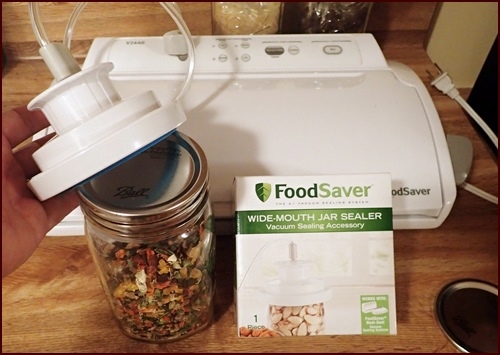
Photo above: My FoodSaver Wide-mouth Jar Sealer in America. I don’t have one in Switzerland. Jars & Oxygen AbsorbersJars are great for storing dried foods until you are ready to assemble meals for a trip. They are more economical than disposable vacuum seal bags, and there’s no plastic waste. You score green points for reusing jelly, sauce, and pickle jars.In the absence of the FoodSaver Wide-mouth Jar Sealing system, oxygen absorbers do a fine job of gobbling up the oxygen, and they only cost a few pennies each. Of course, you’ll want to clean and dry the jars and lids thoroughly before repurposing them for dried food storage.
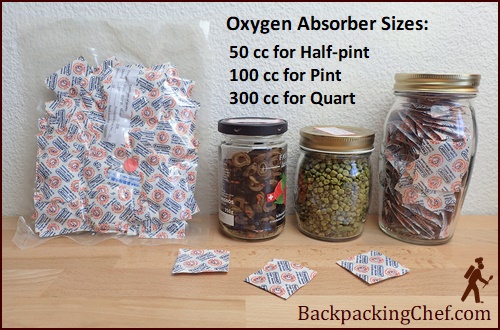
Photo above: (l-r) 100 oxygen absorbers as they arrived in a sealed bag, dried olives and peas in small jars, and oxygen absorbers stored in a jar after I opened a package. Oxygen Absorber Tips:Use the smallest jar that will hold the dried food. There will be less oxygen to remove if the jar is filled all the way with food.A leading supplier, PackFresh USA, recommends a 50 cc absorber for half-pint jars filled with dried food, 100 cc for full-pint jars, and 300 cc for full-quart jars. Most of my jars are pint-size or less, so I just use the 100 cc size oxygen absorbers. Once you open a package of oxygen absorbers, take out what you need for immediate use, and transfer the rest to a glass jar.

Photo above: Chest of drawers used to store dried food. Exposure to light impacts the quality of dried food over time. A chest of drawers blocks light and is very convenient for accessing the jars. Label the lid of the jar with the name of the food and the date dried. For short term storage of a month, there shouldn’t be much negative impact on your dried food if you store it in jars without oxygen absorbers. For longer term storage of up to a year, using oxygen absorbers or vacuum sealing are highly recommended. I’ve decided to use them even for short term storage, as sometimes I store dried foods longer than expected. Oxygen Absorber Resource:PackFresh USA PackFresh USA manufactures oxygen absorbers and provides a lot of information on their website. They also sell Mylar bags, which you can use together with oxygen absorbers. You don’t need a vacuum sealer if you pack meals in Mylar bags with oxygen absorbers. Their website has instructions for how to heat-seal Mylar bags.
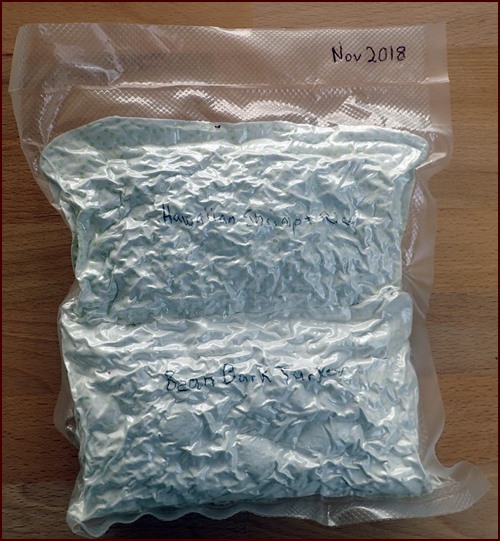 I’m still packing assembled meals in vacuum-sealed bags, but the Mylar bag system works, too. The photo above shows a two-pack of Hawaiian Shrimp & Rice and Bean Bark Stew. These were dried back in November 2018 for the Action Guide: Dehydrating 31 Meals. Note that I wrapped each meal in a paper towel to cushion the bag from the sharp edges of food. The bag held its seal.
I’m still packing assembled meals in vacuum-sealed bags, but the Mylar bag system works, too. The photo above shows a two-pack of Hawaiian Shrimp & Rice and Bean Bark Stew. These were dried back in November 2018 for the Action Guide: Dehydrating 31 Meals. Note that I wrapped each meal in a paper towel to cushion the bag from the sharp edges of food. The bag held its seal.
One advantage of using Mylar bags with oxygen absorbers is that the bag does not scrunch up around the sharp edges of the dried food. That scrunching is what sometimes causes vacuum-sealed bags to fail. If you’re already invested in a vacuum sealer and want to continue using it, there’s another way to reduce the problem of bag punctures: Enclose an oxygen absorber and hit the seal button of the vacuum sealer before the bag gets to the scrunching stage. The oxygen absorber will finish the job.
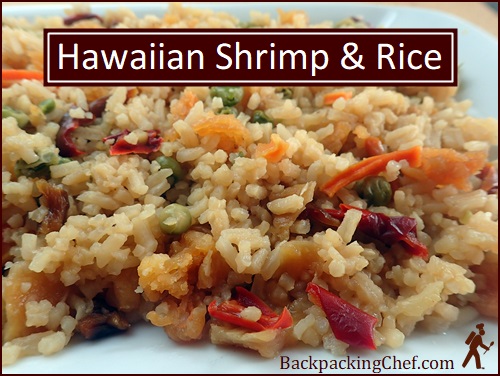 Although I try to use up dried meals within six months to a year, this one escaped my attention until last month. It was still good after two years.
Although I try to use up dried meals within six months to a year, this one escaped my attention until last month. It was still good after two years.
Coming Next Month:Recipes for Adventure IIHard to believe, but it’s been eight years since I published Recipes for Adventure: Healthy, Hearty & Homemade Backpacking Recipes. Thank you to all who bought the book. It continues to sell well in both eBook and print formats, and the recipes are still some of the favorites that Dominique and I prepare in our thermos for hiking and travelling.I announced some time ago that I was working on a follow-up book to the first one. Many of the ideas for the new book ended up going into the newsletters, which often took a week to produce – testing recipes and drying techniques, rehydrating meals, taking photos, writing, editing, and finally formatting the newsletters and hitting the send button. After each issue went out, Dominique would ask, “Did you spill the beans?” After one hundred newsletters, I have spilled quite a few beans. But, I do enjoy what I do – helping people enjoy their trail meals as much as the scenery. Recipes for Adventure II is a collection of “The Best of Trail Bytes,” plus new material I somehow managed to hold back. The stories that went along with the newsletters have been edited out, so what remains is the clear “how-to” of the recipes and techniques. Every recipe has been updated and improved. The topics are organized into categories, rather than the chronological order in the archives. With just a bit more editing left to do, the book is weighing in at two hundred pages.
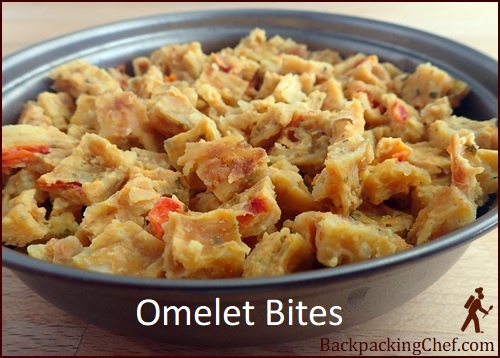 Sneak Peek: In Recipes for Adventure II, there’s a new way to dehydrate eggs that rehydrate really well. Recipes include Spanish Omelet Bites with Onions, Ham & Cheese Omelet Bites, Baked Bean & Tomato Omelet Bites, Broccoli & Tomato Omelet Bites, and Sausage-Seasoned Ground Beef Omelet Bites. Also new in the breakfast category are vegan Pancake Bites and seriously delicious Cream of Pancakes.
Sneak Peek: In Recipes for Adventure II, there’s a new way to dehydrate eggs that rehydrate really well. Recipes include Spanish Omelet Bites with Onions, Ham & Cheese Omelet Bites, Baked Bean & Tomato Omelet Bites, Broccoli & Tomato Omelet Bites, and Sausage-Seasoned Ground Beef Omelet Bites. Also new in the breakfast category are vegan Pancake Bites and seriously delicious Cream of Pancakes.
Recipes for Adventure II will launch as an eBook next month. I will likely offer it as a printed book later, but that will require more work and professional services. I’d love to hear your preference – eBook or printed book? Contest: What’s Your Favorite Recipe from Trail Bytes?Five Prizes Awarded: Free copy of Recipes for Adventure II.Send me a note naming one (or more) recipes from past issues of Trail Bytes that you enjoyed, or one that you’re eager to try on your next trip. Feel free to add a few short details about how it made a trip special or what you liked about it. Simply reply to this email with your note. I’ll pick five winners randomly from the responses. Thank you for your support. See you next month with the new book. Freundliche Grüsse,
Chef Glenn & Dominique P.S. To contact me, please reply to this email or use this contact form. 
If you received this newsletter from a friend and would like to subscribe (it's free), subscribe here. Visit my BackpackingChef Facebook page for the lastest posts. Be sure to "follow" the page to continue seeing posts.
|
| Back to Back Issues Page |